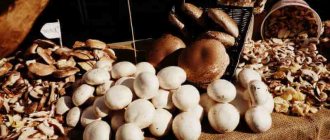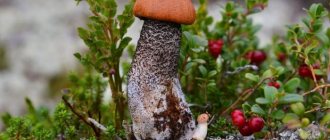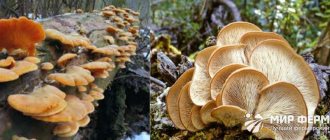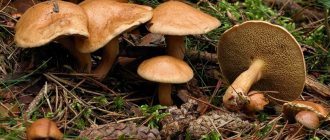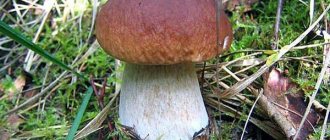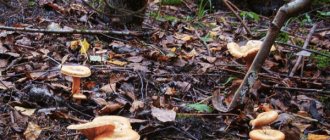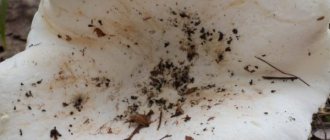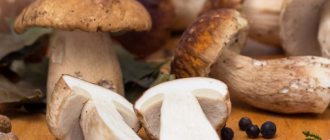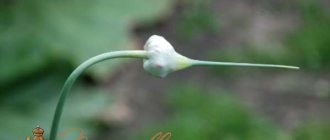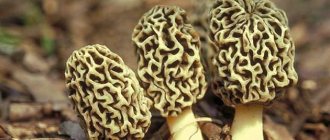People never get tired of mushrooms. Their choice is simply huge. Mushrooms can be fried, made into soups, pickled, pickled for the winter, even dried. They can be edible, for example, like fly mushrooms, porcini mushrooms, boletus mushrooms, aspen mushrooms, etc., and poisonous - like fly agaric mushrooms, toadstools, etc. But even conditionally edible ones can also be eaten when properly prepared. When do mushrooms start growing? From May, you can already collect the very first ones, which are called early, or the first wave.
How fast do mushrooms grow?
How fast does a mushroom grow? The question of how long boletus grows can be answered this way: mushrooms generally grow faster than many plants that people usually eat. In one or two days it grows from being invisible to mushroom pickers to a decent size. The cap varieties grow especially quickly. How long does the porcini mushroom grow? Quite quickly under favorable conditions. And the boletuses and boletuses almost keep up with the boletus mushrooms. But on average, most mushrooms reach large sizes in 3 to 6 days.
How fast does a mushroom grow? If conditions are favorable, then even after one night you can already collect boletus and russula. But we are talking about those mushrooms that are already on the surface. Most of their growth still takes place underground. Rapid appearance on the surface is affected by rain and sun. The growth rate is still greater at night than during the day. For example, you can find out how long a porcini mushroom is growing by simply measuring a small young fungus in the mycelium and measuring it every day. They usually grow completely within two days.
The very first boletus, boletus, boletus, white and many others can be found near large trees or not far from them, where there are fewer small and young roots. And in young forests you practically cannot find them at this time. Only closer to August will mushrooms begin to grow evenly throughout all areas. At the end of the mushroom season, they again begin to be found most often in old forests. True, there is an exception - these are boletus and saffron milk caps. They prefer young growths and edges.
At what speed do milk mushrooms grow? How long does boletus grow after rain?
The mycelium of the boletus is located almost on the surface, i.e. under the top layer of soil - at a depth of 10-15 cm. Therefore, good rain and warm sunny weather are needed. Only under such conditions will the mycelium grow.
Oilseeds are collected in young coniferous forests, as well as in open, well-lit clearings. They grow in large families, which allows you to collect a whole basket in one place. An important role for mushroom picking is played by how much boletus grows after rain.
It is worth noting that boletus on a good mycelium after rain begins to grow the very next day. If a mushroom picker wants to collect strong young boletus, then you should go “hunting” after 12-18 hours.
How long it takes boletus to grow after rain depends on the condition of the soil, lighting, air temperature, etc. On average, 2-3 days are enough to reach full maturity of the mushroom. But do not forget that boletus mushrooms are “fast” mushrooms, which means they will also begin to spoil quickly. The most important thing here is to correctly calculate the moment of going into the forest.
Every mushroom picker knows that the main harvest of boletus occurs in August, September and early October. Therefore, how long boletus mushrooms take to grow depends on two main factors. The first, as already mentioned, is well-moistened soil, and the second is a warm and sufficiently illuminated upper layer of the mycelium.
Many knowledgeable mushroom pickers claim that it takes very little time for an oil can to rise from the ground. So, how long does the butterfly mushroom grow after warm rain? 5-7 hours are enough, and a young, clean, small mushroom appears in the basket. By the way, it is precisely these butters that are highly valued for marinating in jars because they have a beautiful appearance and the appropriate size.
As you can see, in order to correctly determine how much an oil can grows, it is necessary to take into account weather conditions and the characteristics of the local climate. They must be suitable, because even after heavy rainfall, boletus may not appear. Sometimes it happens that there is a lot of moisture, but there is no sunlight and heat. Or the soil is poorly saturated with moisture, and the sun greatly heats the air and the mycelium dries out.
How does porcini mushroom grow?
They grow all summer, but in “waves.” Kolosoviki are the first species to appear. In order to be absolutely sure that whites can be found, you can go on a quiet hunt at the end of June. The second wave begins approximately from mid-August until September. This time is considered the most fruitful. But it can be very short, maybe even a week. But the third “wave” largely depends on the autumn weather. In October, even on a frosty morning you can find late boletus mushrooms.
Porcini mushrooms do not like to be alone; they grow several at a time. Therefore, if one is found, then the rest are nearby. They can also quite often be found in the vicinity of fly agarics, which appear at the same time as them. How fast does porcini mushroom grow? Not very fast, up to 7 days.
What affects the growth rate of mushrooms
In rainy autumn, mushrooms can be found in any forest clearing. It is more difficult to find them in dry autumn weather, as they hide under trees in the shade.
The speed and quality of the fruiting body is affected by:
- Temperature conditions. The growth rate begins at temperatures ranging from 18° C to 30° C. The development process may decrease noticeably if the temperature begins to fluctuate;
- An indicator of soil and air humidity. It should be 70%. If after heavy rains there is a period of prolonged drought, the growth rate is significantly reduced as moisture evaporates into the air;
- Parasites. Development is also affected by the appearance of various insects. As a result of infection of fruiting bodies and myceliums by the larvae of various parasites, their vital activity significantly deteriorates.
Growth is due to many factors that prevent the rapid development of fungi. Before you go to collect a natural harvest, you need to study the weather and its effect on the mushroom.
You can learn what an analytical mindset means from the publication on our website.
Read about the longest hair in the world in this article.
From here you will learn how to correctly determine the size of a woman's breasts.
False porcini mushrooms
False mushrooms in the forest are always very similar in appearance to edible ones. But this is only at first glance. You can still tell them apart if you look closely. The white false one has the same massive leg, and its base is the same - in the form of a barrel. In order to distinguish poisonous from good, they look directly at the fruiting body. The false flesh will turn pink when cut. But cut on white - no. In addition, the poisonous one has a small pattern - like a mesh - on the upper part of the leg. But whites just don’t have it at all. Unfortunately, it is this mesh that often misleads mushroom pickers, who mistake the false white for boletus. In a poisonous mushroom, the tubular layer has a pinkish or dirty white tint. Well, the easiest way is to taste it. False mushrooms produce bitterness. Even just by licking a piece, you can immediately feel it. And with subsequent heat treatment it intensifies even more.
Mushroom time
How fast does a mushroom grow? The very first ones appear in April. First, the real morel grows, followed by a conical and morel cap. In May-June, the pitted lobe appears. This mushroom grows up to 10 cm in height.
These types of morels are considered conditionally edible, since these mushrooms are very poisonous in their raw form. The poison in them is destroyed only after preliminary soaking and prolonged boiling (about an hour). It’s best to boil them this way even three times, draining the water and rinsing each time.
As a general rule, mushrooms begin to grow as soon as the soil thaws. But the real first ones are the spikelets, which begin to appear when the grain begins to spike. But often boletus, boletus, chanterelle, aspen and boletus appear in the forests already in May.
The best time to collect different types of mushrooms is in summer and autumn
The first mushrooms appear in April, but May is considered the official opening month of the mushroom season. Usually mushroom hunting lasts until October inclusive. But if weather conditions are favorable, new mushrooms grow in November and even in December.
It is better to harvest according to the mushroom calendar. Based on his data, the mushroom picker is less likely to run into an inedible double. The following table details the entire growth period of certain edible species.
| Species name | May | June | July | August | September | October |
| Porcini | + | + | + | + | + | |
| Valuy | + | + | + | + | + | |
| Volnushka | + | + | + | + | + | |
| Volnushka white (Belyanka) | + | + | ||||
| Gorkushka | + | + | + | + | ||
| Gruzd | + | + | + | + | ||
| Raincoat | + | + | + | + | + | |
| Greenfinch | + | + | + | |||
| Kozlyak | + | + | + | + | ||
| Cap | + | + | + | + | ||
| Chanterelle | + | + | + | + | + | |
| Oiler | + | + | + | + | + | |
| Mosswort | + | + | + | + | ||
| Honey fungus | + | + | + | |||
| boletus | + | + | + | + | + | + |
| Boletus | + | + | + | + | ||
| Ryzhik | + | + | + | + | ||
| Ryadovka | + | + | + | |||
| Serushka | + | + | + | + | ||
| Violin | + | + | + | |||
| Morel | + | |||||
| Russula | + | + | + | + | + | + |
| Champignon | + | + | + | + |
The first harvest is much smaller than the harvest collected during the period of active mushroom growth. The following provides data on the peak growth activity of certain edible species.
| Species name | May | June | July | August | September | October |
| Porcini | + | + | ||||
| Valuy | + | + | ||||
| Volnushka | + | |||||
| Volnushka white (Belyanka) | + | |||||
| Gorkushka | + | + | + | |||
| Gruzd | + | + | ||||
| Raincoat | + | + | ||||
| Greenfinch | + | + | ||||
| Kozlyak | + | + | + | |||
| Cap | + | + | ||||
| Chanterelle | + | + | ||||
| Oiler | + | + | ||||
| Mosswort | + | |||||
| Honey fungus | + | + | ||||
| boletus | + | + | ||||
| Boletus | + | + | + | |||
| Ryzhik | + | + | ||||
| Ryadovka | + | |||||
| Serushka | + | + | ||||
| Violin | + | + | ||||
| Morel | + | |||||
| Russula | + | + | + | + | ||
| Champignon | + | + | + | + |
An interesting fact is that during Indian summer you can find varieties from all seasons of the year. And after it, mushroom pickers can only collect the remains of the autumn harvest and winter honey mushrooms.
In which forests do mushrooms usually grow?
Mushrooms, of course, grow in the forest, but still they can be found much more often on the edges, in small forests, on the outskirts, along the banks of ditches, rivers and streams. It is best to look at the entrance to the forest, not to go too far into it, but to walk along the edge, preferably on the south side.
There is an opinion that mushroom pickers do not explore the area adjacent to the road only because they believe that everything has already been collected there and are trying to move further away. Meanwhile, this is where intact myceliums are often found. Porcini mushrooms are very partial to cow trails. If cattle are usually driven along the edge of the forest, then this is where you should look for them first. This type of mushroom is nicknamed “bug”.
Mostly whites love spruce forests, although they often grow in pine forests. The best place for them is the outskirts of mixed forests.
But aspen boletuses prefer young plantings of aspen and birch. They are mostly found on the slopes of streams, ditches and small rivers. In order to find mycelium, you do not need a large area of forest. It’s not uncommon to come across a whole family among three aspen trees and a pair of birch trees. And from one mycelium alone they cut up to 20 pieces.
The boletus is sure to be found where there are birch plantings. The ideal place for collection is in sparse young plantings. It is here that the “king” of boletus grows – the blackhead, which is considered the most delicious and beautiful. You can find it by its small dark cap, since the main part is completely surrounded by moss.
Saffron milk caps and butterflies love coniferous forests, especially pine forests. Milk milk, chanterelles, honey mushrooms and russula are generally unpretentious, and you can stumble upon them in any forest.
How long does it take for mushrooms to grow after cutting?
Perhaps none of the plants widely used by humans for food grows as quickly to a ripe state as a mushroom. Hence the expression “grows like a mushroom.” However, in the minds of mushroom pickers, the growth rate of mushrooms is usually exaggerated. This happens because some of the mushrooms go unnoticed during collection. When visiting the site again after a day or two, mushroom pickers find mushrooms of considerable size. Cap mushrooms grow very quickly. Over the course of one, several days, and even part of a day, porcini mushrooms, aspen mushrooms and boletus mushrooms significantly increase in size. Most mushrooms grow to medium size in 3-6 days. Under favorable weather conditions, boletus, boletus, and russula can be collected within a day or even a night after they appear on the soil surface. The fact is that the fruiting bodies of the most famous cap mushrooms first form underground, grow there for a long time and emerge almost fully formed to the surface. However, even after this, their growth until full ripening can continue for 8-12 days. Infection with fly and mosquito larvae slows down or stops the growth of mushrooms. During the day, the mushrooms grow by an average of 1-1.5 centimeters in the total height and diameter of the cap. But even among mushrooms of the same species, for example, boletus, the daily growth ranges from 3 millimeters to 3 centimeters, which is due to their individual characteristics and condition. In the first 5-8 days, the growth of the mushroom, both in total height and in diameter of the cap, occurs quite evenly. The growth of mushrooms in height stops one to two days earlier than the growth of the cap in diameter. A day after growth stops, the mushroom is destroyed. Some argue that there is no significant difference in the growth rate of mushrooms at night and during the day. Sometimes there is a noticeable increase in fungal growth after precipitation. And yet, mushrooms appear to grow most at night. You walk through the forest in the evening - there are no mushrooms, it’s empty. And in the morning, the young mushrooms are right there, asking to be put in the basket. So light has little effect on the development of mushrooms, because the mushroom is a child of the shadow. In the summer-autumn period, the average weight of fresh mushrooms on the fourth day of their growth is expressed by the following values: porcini mushroom - 160 grams, boletus - 74, boletus - 45, oiler - 35, moss - 33, chanterelle and goat - 9, milk mushroom - 79 , volushka—17, russula—12 grams. In which forests are the conditions most favorable for mushroom growth? Some argue that mushrooms grow better in young forests, in which the mycelium filaments get along better with young, small, soft-barked tree roots. These roots are located in the top layer of soil and are accessible to fungi. In older trees, the roots are located deep in the ground, so they are less accessible to the mycelium. The practice of mushroom pickers confirms the opposite. There are fewer mushrooms in young forests than in old ones. The first porcini mushrooms, aspen mushrooms, boletus mushrooms, boletus mushrooms and others, as a rule, appear on large trees and most often in the immediate vicinity of them, where there are significantly fewer young, small roots at the soil surface. At the same time, these mushrooms are almost impossible to detect in young forests. Somewhat later, approximately in the second half of August - early September, mushrooms grow relatively evenly in both forests. At the end of the season, mushrooms are again found more in old forests than in young ones. The only exceptions are boletus and saffron milk caps, which grow better in young growth and on the edges. The collector is sometimes struck by the unevenness of the mushroom harvest, that they seem to “wander” from one place to another, from one forest to another. This is explained by changes in fungal growth factors. For example, dry, hot weather set in, and there were almost no mushrooms in the elevated, dry places, but in the lower areas of the forest, where excess moisture from the soil evaporated, mushrooms appeared as if by magic. Therefore, mushrooms cannot tolerate either excessive dampness or dryness.
Tips for mushroom pickers
Mushrooms have one unusual “tendency”. They love high-voltage power lines that are strung across forested areas. This feature is explained by the fact that due to electric current, trees are constantly pruned, and this creates quite favorable conditions for growing mushrooms, since they constantly receive the necessary light and moisture.
Mushrooms in the forest can mainly be found in damp places - lowlands, as they grow much faster there. But you definitely shouldn’t look for them in the swamps. You should also remember about the temperature, so in the southern regions the mushroom season begins earlier than in the northern ones.
Common types of tree mushrooms
The most famous tree mushrooms:
- ram mushroom, which can grow up to 20 kg;
- scaly tinder fungus;
- the tubular layer is white, edible, consumed young;
- winter polypore, grows on deciduous trees;
- sulfur-yellow tinder fungus grows in deciduous forests and is eaten when young;
- birch tinder fungus, grows on birch trees, often on dead ones, edible at a young age;
- fistulina grows on living deciduous trees and in oak hollows, edible;
- Psatirella conlolia grows on living trees and soil and is edible;
- golden scale grows in large groups on poplars and deciduous trees and is edible;
- Steppe and common oyster mushrooms are both edible.
Truffle
Truffle mushrooms are considered a delicacy that was available only to wealthy people. They belong to the genus of marsupials. Outwardly, they are quite unattractive, fleshy, and grow in tubers. And they can reach a weight of up to 1 kg. Black and blue, smooth or cracking. Covered with small bumps resembling warts.
This mushroom has many species - almost a hundred, but of all, only three are considered the most valuable. These are winter, Perigord and Piedmontese. It is very demanding regarding the conditions of the environment in which it grows. So where do truffles (mushrooms) grow? They prefer mixed forests, but with a predominance of trees such as beeches and oaks. Despite this capricious behavior, they grow underground.
Features of truffle
The mushroom tastes like roasted sunflower seeds or walnuts. And after that it retains its taste for a long time. It is so bright that it is very difficult to describe. In addition, it can even be consumed raw.
Truffle has many beneficial properties. It is highly valued for its high content of vitamins B1, B2, C, PP. Has a beneficial effect on the health of children, nursing mothers and pregnant women. Increases sexual desire. It has even been proven to delay the aging of human skin. Therefore, it is widely used in cosmetology. You can collect such mushrooms only by tearing up the ground, but only pigs and dogs can feel where the mushroom grows, so there is a real mushroom hunt for these delicacies. Otherwise, it is simply impossible to collect them. These mushrooms grow strictly one at a time. They are collected only at night, since only at this time does it emit a smell.
The truffle season is very short - from September to March. And in winter they can only be obtained in November or December. Most mushrooms are small, since large specimens are extremely rare.
Truffle even has its own expiration date: it can only be stored fresh for up to 3 days. And even then, it needs to be wrapped in paper and put in the refrigerator. It can also be frozen. But all these operations can only be performed with unwashed and uncleaned mushrooms.
Fly agarics
Fly agaric belongs to the genus of lamellar mushrooms. And for the most part it is very poisonous. There are almost 100 species. Grows in all forests. When mushrooms of all kinds begin to grow, then fly agaric mushrooms appear: from June to October. However, we must remember. Red and stinking fly agarics are deadly to humans, as they are very poisonous.
The fly agaric is a type of fly agaric, quite large and fleshy. The young mushroom is wrapped in a blanket, which tears as it grows. The color is different, it can be not only red, but also gray. It reproduces by spores. By the way, when fly agarics grow, porcini mushrooms also appear.
The most common red mushroom in our forests. When consumed by humans, it causes intense hallucinations. But there are also edible fly agarics. For example, Caesar, pink. Red is used in the treatment of oncology, epilepsy and a number of other serious diseases.
Influence of air temperature and lighting
In fact, the growth time of mushrooms directly depends on many reasons and factors. One of them is air temperature. The optimal ambient temperature for most types of mushrooms is from 18 to 28 Celsius. Many species (for example, champignons) develop well in the dark. Meadow mushrooms, on the contrary, need sun - only then can they grow well.
So, how long do mushrooms grow? Very fast! In a few days (from three to six) they reach the average size characteristic of this species; they become large around the tenth day, but even after that they can continue to grow. In the first days, the growth of the fungus occurs faster, then it slows down. Caps take longer to grow than legs. Some insects are known to slow down the growth of fungi. Warm, rainy weather, on the contrary, promotes rapid growth.
